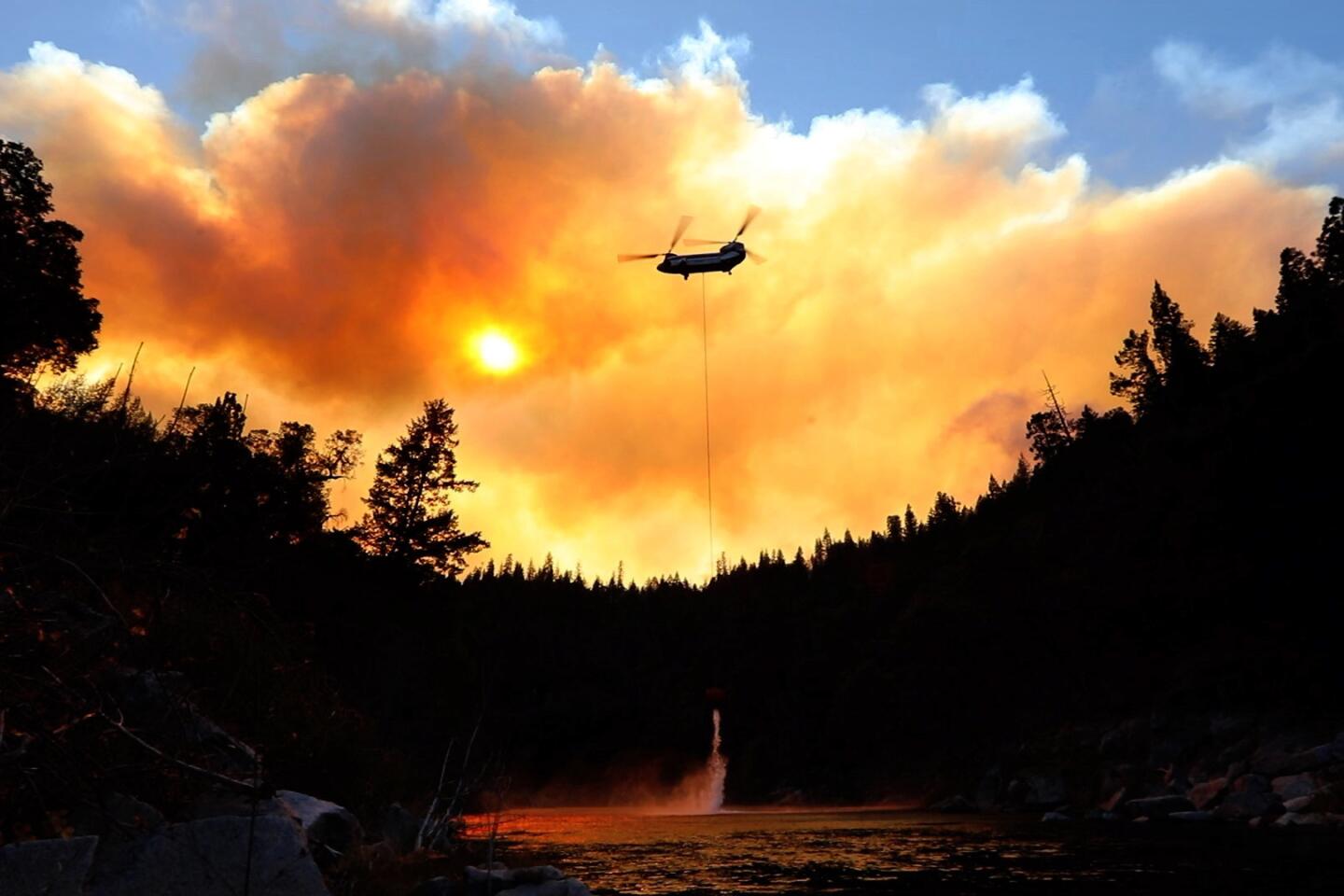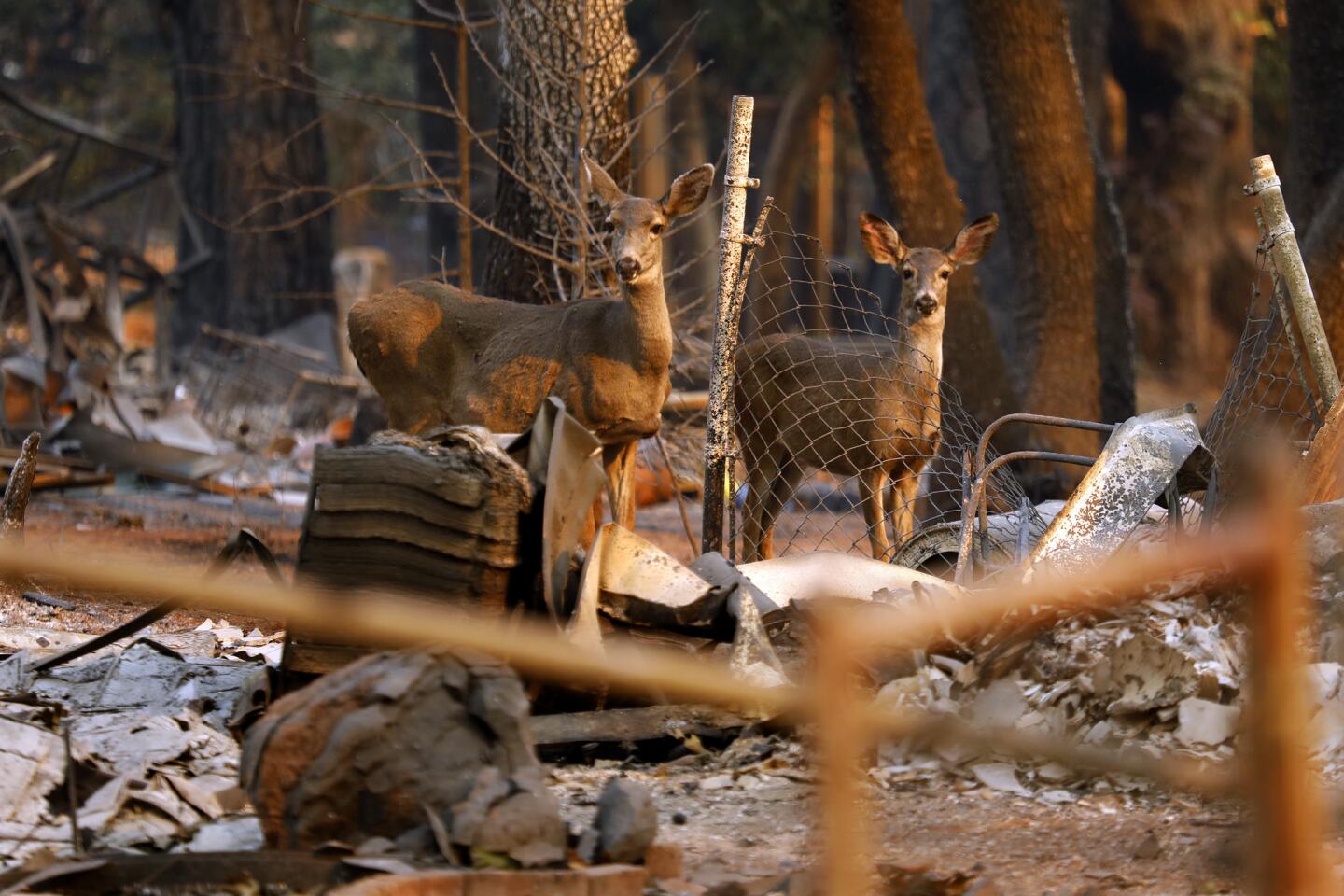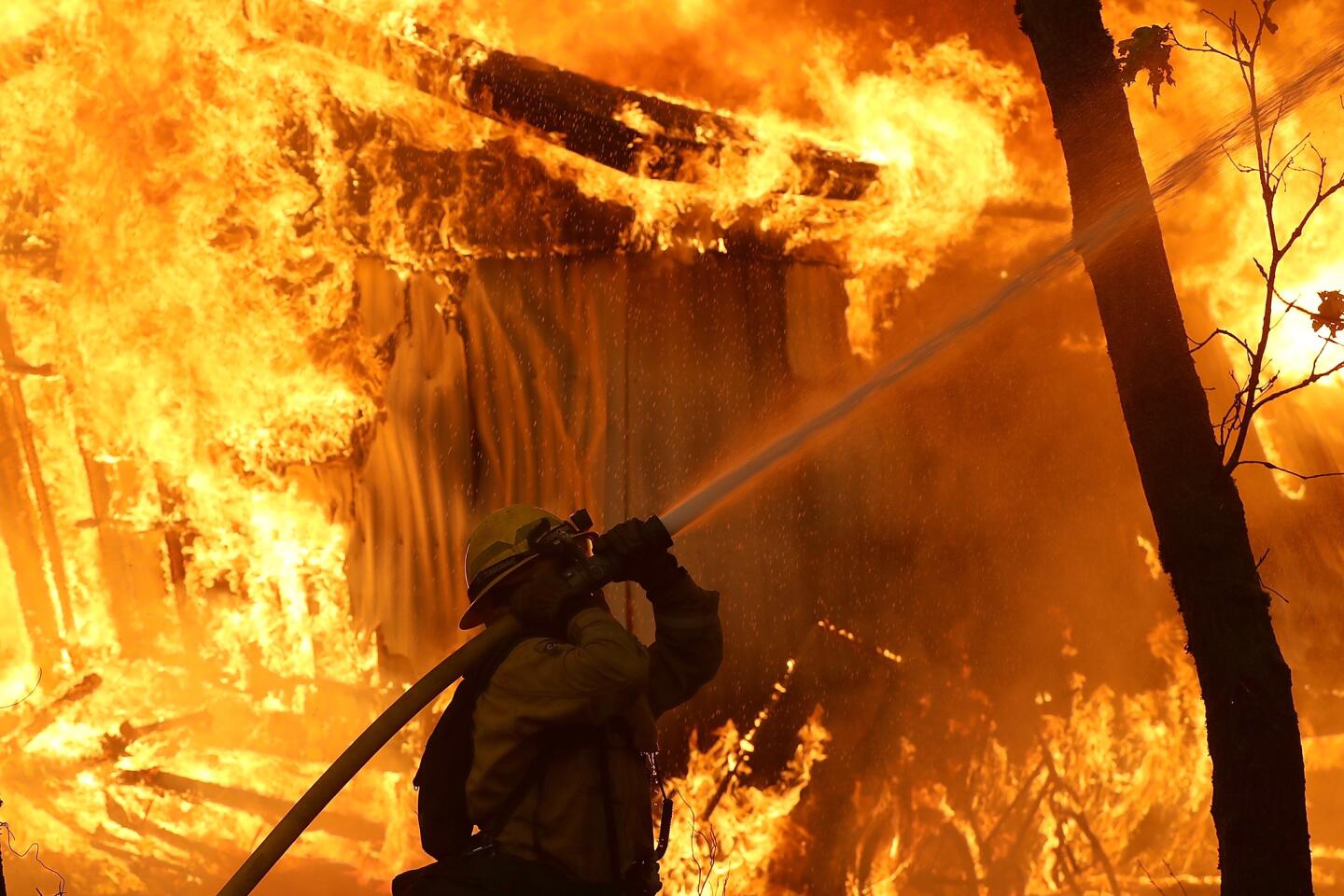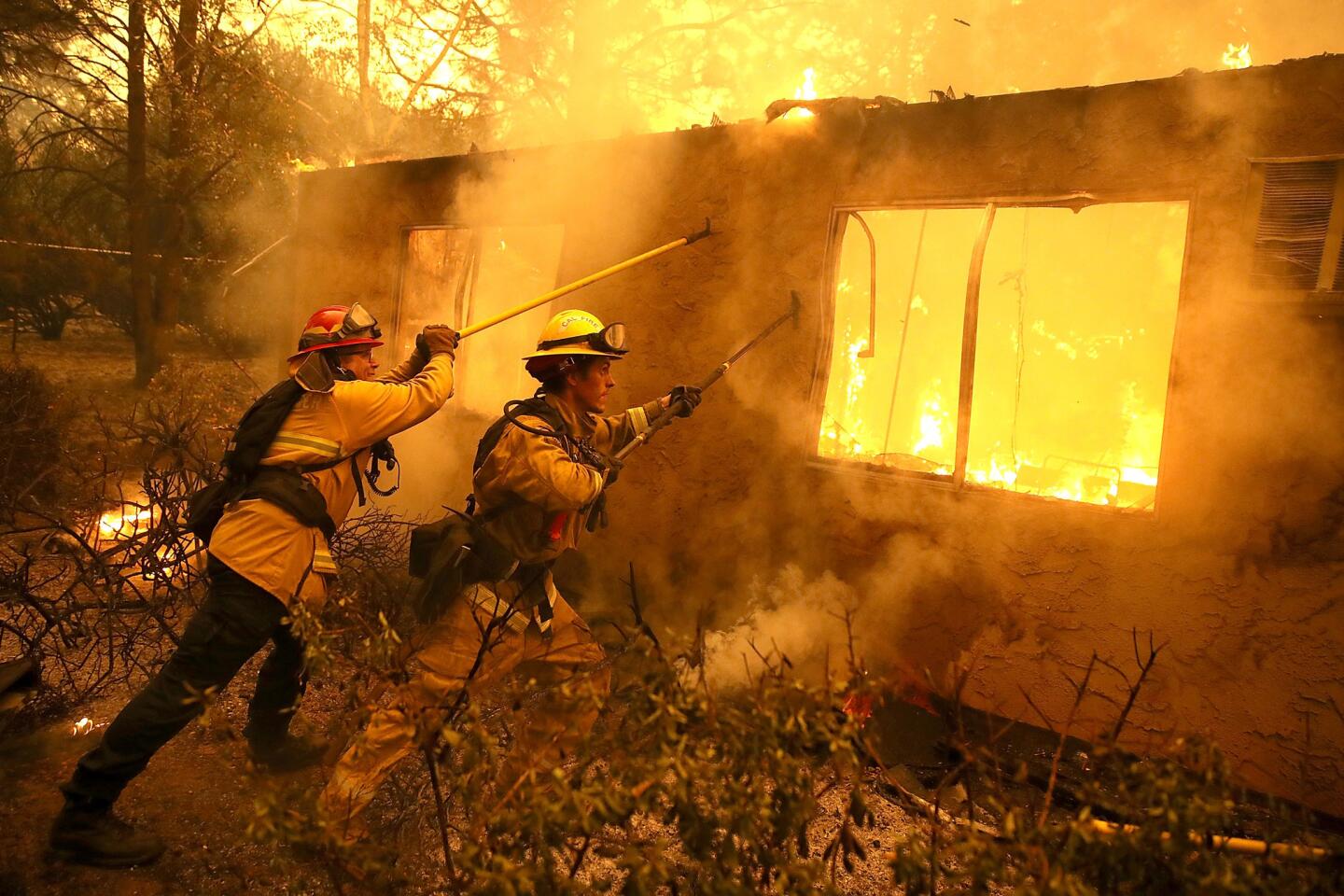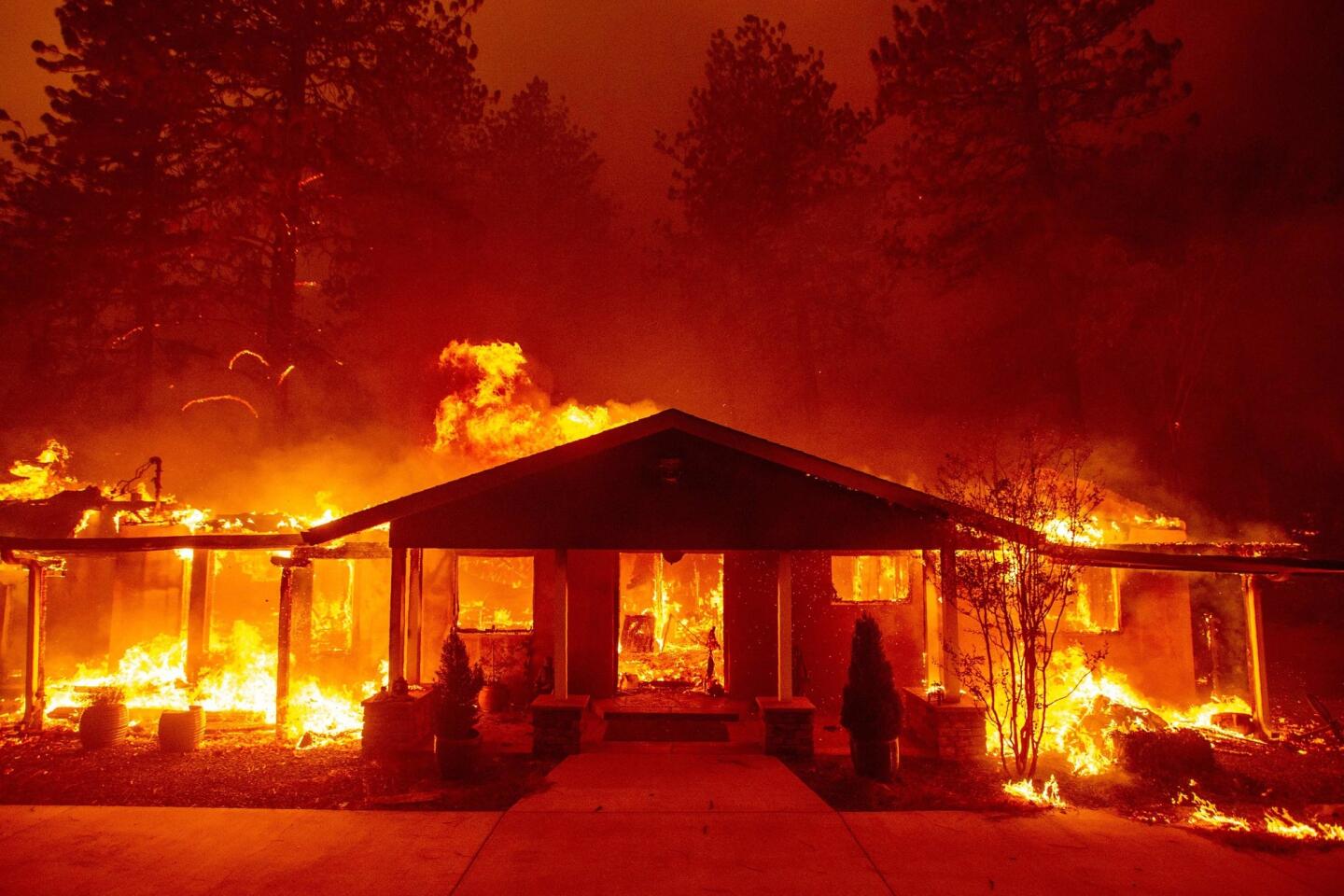Death toll from the Paradise fire jumps to 42, making it the worst in California history
- Share via
The death toll from the Camp fire in Paradise jumped to 42 on Monday, making it the deadliest fire in California history, as President Trump approved a major disaster declaration for the state.
Officials said they recovered the remains of 13 additional victims Monday as teams continued to search the burned-out remains of thousands of lost homes. Ten of those remains were located in Paradise; three were found in the Concow area.
Three of the victims were identified Monday as Ernest Foss, 65, of Paradise; Jesus Fernandez, 48, of Concow; and Carl Wiley, 77, of Magalia.
Trump’s move came just two days after he criticized California, erroneously claiming that poor forest management caused the fires of the last week and threatening to cut off funding. His comments were met with widespread outrage from both California officials and many firefighters.
But on Monday, Trump struck a more conciliatory note.
“I just approved an expedited request for a Major Disaster Declaration for the State of California,” he wrote on Twitter. “Wanted to respond quickly in order to alleviate some of the incredible suffering going on. I am with you all the way. God Bless all of the victims and families affected.”
Gov. Jerry Brown sought the declaration Sunday, as fires raged both in Butte County and in Southern California.
The Woolsey fire, which broke out Thursday in Ventura County and spread to Malibu, has obliterated roughly 435 homes and businesses. However, California Department of Forestry and Fire Protection officials said about 15% of the burn area has been surveyed for damage, so the number of structures damaged in the inferno probably will increase. About 57,000 structures are still threatened, and the blaze has already killed at least two people, authorities said.
A couple whose charred bodies were found in a vehicle in Malibu on Friday probably died trying to escape the flames, Los Angeles County Sheriff’s Department Sgt. Guillermo Morales said.
Investigators are still trying to identify the car’s driver and passenger, both of whom were burned beyond recognition, Morales said. Investigators don’t think the two lived at a home on Mulholland Highway. The home’s residents “have been accounted for,” Morales said.
“This driveway looks like a small road. It’s not like a normal driveway, and the whole landscape around there is burned to a crisp. We think they were probably overcome by the flames,” Morales said.
On Monday, the remnants of two cars were visible about a third of a mile up a long, curving driveway, beyond an electronic gate at 33133 Mulholland Highway that had been left open. Scattered across the pavement were a few fragments: screws, broken glass, pools of melted metal. A softened windshield was draped over the cliffside.
A lull in winds over the weekend allowed firefighters to make some headway with the blaze, boosting containment to 20%, Cal Fire Division Chief Chris Anthony said. However, Santa Ana winds that arrived Monday morning and are expected to gain strength through Tuesday could cause the fire to spread erratically. By Monday night, the blaze was 30% contained.
Northeast winds are expected to blow 20 to 30 mph, with gusts up to 55 mph in Los Angeles, according to the National Weather Service. A red-flag warning — signifying a potent mix of heat, dry air and winds that could explode a small fire into a deadly conflagration — has been issued for the region.
Anthony said the main push for firefighters through the day will be preventing burning embers from jumping outside the containment lines, and keeping the Woolsey fire from spreading to Topanga Canyon.
“We didn’t see any spread of fire outside the containment lines on Sunday, but as we’ve clearly seen over the last couple of days, it only takes one ember and one new spark to see rapid rates of fire spread,” he said.
As fire officials saw on Friday, windy conditions can be perilous for communities in the path of a wildfire. Strong winds accelerated the Woolsey fire’s growth as it burned into Malibu, forcing residents to flee quickly as flames engulfed homes, leaving behind only wreckage and a few charred memories.
Nearby, the long, twisting roadways of the city felt like a moonscape. The streets through the Santa Monica Mountains, damaged in places, were framed by scorched speed limit signs and drooping power lines. The fire had burned unevenly, leaving some swaths of land barren and gray. In other areas, unscathed trees and vineyards swam into view in vivid color. Solar panels glinted from scorched hillsides.
The silence was punctuated by the beep-beep-beep of utility trucks, the whir of helicopters dropping water and the roar of the wind blowing ash and dust across the hills. The shoulder of Mulholland Highway was filled with trash, burnt palm fronds and the remnants of people’s homes: a New Yorker subscription card, a page from a 1977 yearbook, a half-burned ticket for going 101 mph in a 60-mph zone.
Along a path of wood chips that crumbled when touched, a white yurt stood intact and pristine, surveying a valley of scorched earth and twisted trees. Stone letters on a ridge nearby spelled out: “LOVE.”
Investigators are still trying to determine what sparked the Woolsey fire. Southern California Edison told state regulators last week that there was an outage tied to its Chatsworth substation two minutes before the fire was reported near Simi Valley, but authorities have not connected the incident to the blaze.
Full coverage of the California wildfires »
“At this point we have no indication from fire agency personnel that Southern California Edison utility facilities may have been involved in the start of the fire,” Edison wrote in an incident report to the California Public Utilities Commission.
Edison wrote that a circuit relayed at the facility at 2:22 p.m. Thursday. Sally Jeung, a spokeswoman for Edison, told KQED-TV that “when a circuit relays, [it] senses a disturbance on the circuit and switches the circuit off.” It’s not clear what triggered the circuit’s sensor.
Edison said that at the request of firefighters, it could turn off power Monday in certain areas affected by the fire, but that such steps so far had not been needed. However, the blaze has damaged Edison infrastructure and equipment, leaving more than 9,000 customers without power, according to the utility.
Officials urge residents who are sheltering in place to evacuate and those who already have left their homes to stay away.
“Maybe 10 or 20 years ago, you stayed in your homes when there was a fire, and you were able to protect them,” Ventura County Fire Chief Mark Lorenzen said Sunday. “Things are not the way they were 10 years ago.”
Malibu, Calabasas, Hidden Hills, Monte Nido, Gated Oaks, Topanga, Bell Canyon and portions of Westlake Village and West Hills remain under evacuation orders.
In Butte County, a red-flag warning that has been in effect for days was set to expire Monday morning, but as commanders warned crews during their morning briefing at the Silver Dollar Fairgrounds in Chico, that doesn’t mean the fight against the Camp fire is anywhere near won. The fire had scorched 117,000 acres by Monday night and was 30% contained.
Most of that spread was on the blaze’s northeastern flank toward Sterling City and deeper into the Sierra Nevada and to the southeast, where it jumped the Feather River, officials said.
The fire is expected to transition from being wind-driven to topography- and fuel-driven, making it more predictable, but still potentially explosive as it approaches overgrown, tinder-dry landscape.
Fire officials said Californians should prepare for an increasingly long and potentially deadly fire season. Low precipitation, high temperatures and dry brush have combined to create treacherous fire conditions in the state.
“You have fuels that are dry, no precipitation and low humidity,” Anthony said. “Those are the perfect ingredients for explosive, dynamic fire growth. Our fire problem is only getting worse. It’s getting worse in ways that I don’t think people could predict.”
Times staff writers Alene Tchekmedyian, Alejandra Reyes-Velarde and Sonali Kohli contributed to this report.
hannah.fry@latimes.com | Twitter: @Hannahnfry
joseph.serna@latimes.com | Twitter: @JosephSerna
UPDATES:
10:55 p.m.: This article was updated with the identification of three victims and additional fire figures.
6:35 p.m.: This article was updated with new fatality figures.
2:30 p.m.: This article was updated with information about deaths in Malibu.
12:40 p.m.: This article was updated with additional information about Malibu and the Peak fire.
11:10 a.m.: This article was updated with new figures for structures destroyed and acreage burnt and a freeway closure because of fire.
10:20 a.m.: This article was updated with information from Southern California Edison.
This article was originally published at 9:40 a.m.
More to Read
Sign up for Essential California
The most important California stories and recommendations in your inbox every morning.
You may occasionally receive promotional content from the Los Angeles Times.







